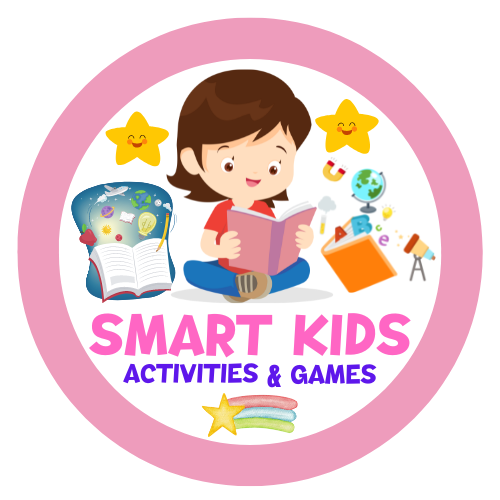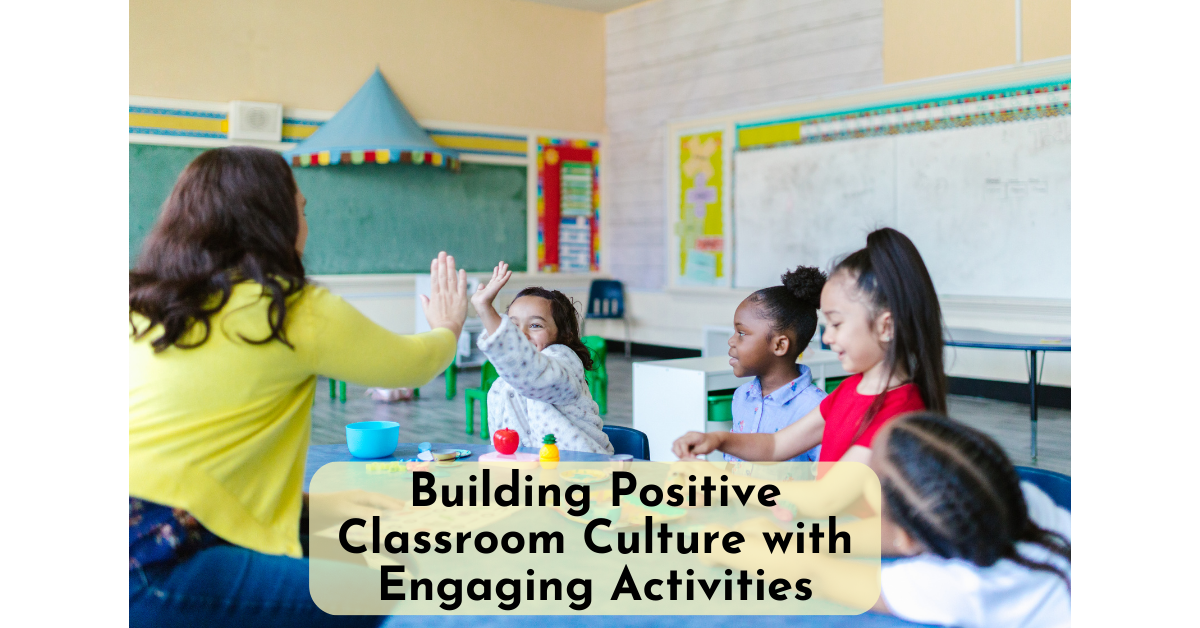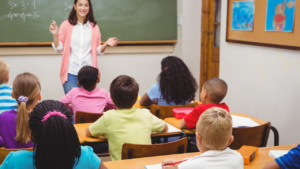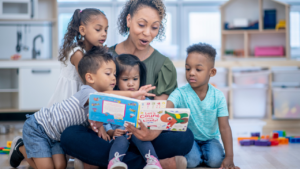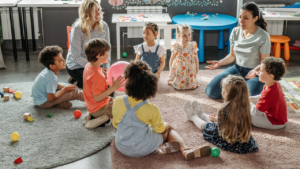Creating a positive classroom culture is crucial for fostering a conducive learning environment. By implementing engaging activities, teachers can cultivate a sense of belonging, promote positive behavior, and enhance collaboration and engagement among students. In this article, we will explore effective strategies for building a positive classroom culture and creating a vibrant and supportive learning environment.
Key Takeaways:
- Incorporate activities that help students get to know each other, such as creating welcome messages for the classroom.
- Implement special greetings, like personalized handshakes, to build connections with students.
- Start the day with morning meetings to focus on social-emotional learning and promote a sense of belonging.
- Cultivate a growth mindset by emphasizing the power of “yet” and encouraging students to embrace learning challenges.
- Build connections and foster a sense of community through “me too” activities that encourage students to share their interests.
Getting to Know Each Other with Welcome Messages
Building a positive classroom culture begins with creating an inclusive and welcoming environment. One effective way to achieve this is through the use of welcome messages that reflect the unique culture of the class. By engaging students in the process of creating these messages, they feel a sense of ownership and belonging right from the start.
Teachers can encourage students to design welcome signs, posters, or even welcome mats that showcase their individuality and personalities. These visual displays not only brighten up the classroom but also serve as a reminder that every student’s presence is valued and appreciated.
“Welcoming messages create a sense of belonging and foster positive relationships among students. They set the tone for the entire school year, establishing a classroom culture based on inclusivity and acceptance.” – Sarah Johnson, Education Specialist
Through these welcome messages, students get to know each other and develop a deeper understanding and appreciation for their classmates’ backgrounds, interests, and experiences. This activity promotes empathy and encourages students to see the value in diversity, fostering a positive classroom culture where everyone feels respected and accepted.
| Benefits of Welcome Messages | Key Elements |
|---|---|
| 1. Foster a sense of belonging. | 1. Personalized messages that reflect each student’s personality. |
| 2. Promote positive relationships among students. | 2. Visual displays that brighten up the classroom. |
| 3. Encourage empathy and acceptance of diversity. | 3. Showcasing students’ backgrounds, interests, and experiences. |
By incorporating welcome messages into the classroom, teachers set the stage for a positive learning environment, where students feel comfortable and motivated to participate actively. This activity is just the first step in building a positive classroom culture that fosters growth, collaboration, and success.
Special Greetings to Build Connections
When it comes to building a positive classroom culture, special greetings can make a big difference. Rather than diving right into academics, taking the time for personalized greetings can help teachers establish connections with their students. By incorporating special greetings, such as personalized handshakes or simply demonstrating genuine interest in each student’s life, teachers create an environment where students feel valued and respected.
These simple gestures of acknowledgment and warmth go beyond the routine and build a sense of community within the classroom. Students appreciate the effort their teacher puts into learning their names and taking a genuine interest in their well-being. This lays the foundation for a positive and welcoming classroom culture, fostering an atmosphere where students feel comfortable and encouraged to participate.
“Special greetings create a sense of belonging and promote positive relationships between teachers and students. Taking the time to connect on a personal level sets the tone for a supportive and engaged classroom environment. It shows that the teacher values each student as an individual, which boosts their confidence and motivation to learn.”
– Samantha Alvarez, Elementary School Teacher
Furthermore, special greetings set the stage for inclusive classroom practices. By making every student feel seen and acknowledged, teachers can foster an atmosphere of acceptance and respect. This enables students to develop empathy and understanding for one another, creating a positive peer culture.
The Impact of Special Greetings on Classroom Culture
The impact of special greetings can be seen in the positive transformation of classroom culture. When students feel valued and respected, they are more likely to engage in learning, collaborate with their peers, and exhibit positive behavior. Moreover, special greetings provide an opportunity for students to develop their social skills, such as active listening and reciprocating kindness, which are essential for building strong relationships.
By implementing special greetings as part of their daily routine, teachers lay the groundwork for a positive and inclusive classroom culture. This practice not only enhances academic achievement but also contributes to the holistic development of students, nurturing their social and emotional well-being.
| Benefits of Special Greetings | Impact on Classroom Culture |
|---|---|
| Promotes a sense of belonging | Creates a positive and inclusive classroom environment |
| Builds positive relationships between teachers and students | Fosters a supportive and engaged classroom culture |
| Enhances social skills and empathy | Creates a positive peer culture |
| Boosts student motivation and engagement | Improves academic achievement |
Morning Meetings for Social-Emotional Learning
Morning meetings provide an engaging way to start the day and focus on social-emotional learning. These meetings foster a positive classroom culture by promoting a sense of belonging and caring within the classroom, enhancing student engagement and behavior.
During morning meetings, teachers can define empathy and model active listening, encouraging students to show understanding and compassion towards their peers. This activity promotes social-emotional learning, helping students develop essential skills for building positive relationships both inside and outside of the classroom.
Furthermore, morning meetings provide an opportunity for students to ask each other meaningful questions, fostering a sense of curiosity and connection. By allowing students to share and express themselves, teachers create an inclusive environment where everyone’s voice is heard and valued.
Benefits of Morning Meetings for Building a Positive Classroom Culture
Morning meetings contribute to building a positive classroom culture in several ways:
- Promotes a sense of belonging: Morning meetings create a space where students feel welcome and connected to their classmates.
- Fosters empathy: By defining empathy and encouraging active listening, students develop a better understanding of each other’s perspectives and experiences.
- Builds positive relationships: Through meaningful conversations and exchanges of questions, students form deeper connections with their peers.
- Enhances engagement: Morning meetings set a positive tone for the day, promoting student engagement and active participation in classroom activities.
- Supports social-emotional learning: By prioritizing social-emotional learning during morning meetings, teachers help students develop essential life skills, such as communication, self-awareness, and empathy.
Overall, morning meetings are a valuable tool for building a positive classroom culture and promoting social-emotional learning. By starting each day with intentional activities that foster connection, empathy, and engagement, teachers create a classroom environment where students thrive academically and emotionally.
Cultivating a Growth Mindset with the Power of “Yet”
| Building a Positive Classroom Culture |
|---|
| Building a positive classroom culture is essential for creating a conducive learning environment. By implementing engaging activities, teachers can foster a sense of belonging, promote positive behavior, and enhance student collaboration and engagement. One powerful approach to cultivating a positive classroom culture is by focusing on the growth mindset.
The growth mindset is the belief that abilities and intelligence can be developed through effort, perseverance, and a willingness to learn from mistakes. By introducing the concept of “yet,” teachers can help students transition from a fixed mindset to a growth mindset by reframing their thoughts and embracing the idea that they might not have mastered something “yet,” but they have the potential to do so with time and effort. This shift in mindset can have a profound impact on students’ attitudes towards learning and their ability to overcome challenges. Rather than seeing setbacks as failures, students with a growth mindset see them as opportunities for growth and improvement. This positive outlook fosters resilience, perseverance, and a love for learning. To cultivate a growth mindset in the classroom, teachers can:
By creating a classroom environment that values effort and growth, teachers can inspire students to approach learning with enthusiasm and resilience. This lays the foundation for a positive classroom culture where students feel supported, motivated, and empowered to reach their full potential. |
Building Connections through “Me Too” Activities
“Me too” activities are a fantastic way to foster connections and cultivate a strong sense of community within the classroom. By encouraging students to share their interests and find commonalities with their peers, teachers can create a positive and inclusive learning environment where everyone feels valued and supported.
Through “me too” activities, students have the opportunity to discover shared passions and interests with their classmates, leading to the formation of new friendships and the strengthening of existing ones. These activities not only promote social interaction but also enhance collaboration and teamwork skills.
One effective “me too” activity is the “Find Your Match” game, where students search for fellow classmates who share the same hobbies, favorite books, or sports. By working together in small groups or pairs, students can engage in collaborative projects and discussions that spark creativity and boost engagement.
Benefits of “Me Too” Activities:
- Promote a positive classroom culture
- Foster a sense of belonging and inclusiveness
- Encourage collaboration and teamwork
- Strengthen social bonds and friendships
- Spark creativity and engagement
By incorporating “me too” activities into the classroom, teachers can create an environment that celebrates diversity, encourages empathy, and values the unique qualities and experiences of each student.
| Activity | Description |
|---|---|
| “Find Your Match” Game | Students search for classmates with shared interests to engage in collaborative projects and discussions. |
| Interest-Based Clubs | Students form clubs centered around shared interests, such as book clubs or STEM clubs. |
| Storytelling Circles | Students take turns sharing personal stories and experiences, finding common ground and building connections through shared narratives. |
| Community Exhibitions | Students display their hobbies, projects, or skills to the class, allowing others to discover shared passions and interests. |
Reflections for Self-Awareness and Growth
Reflections play a vital role in helping students develop self-awareness and foster personal growth. By dedicating time at the end of each day for reflection activities, teachers can encourage students to thoughtfully consider their learning experiences, take risks, and identify areas for improvement. Engaging in regular reflections not only enhances students’ understanding of themselves as learners but also cultivates a compassionate classroom environment where they feel supported and motivated to grow.
“Reflection is looking back so that the view looking forward is even clearer.”
The Benefits of Reflection
Reflecting on their learning experiences allows students to:
- Gain insight into their strengths and weaknesses
- Identify areas for growth and set goals
- Recognize their progress and celebrate achievements
- Develop a deeper understanding of themselves as learners
- Build self-confidence and resilience
- Enhance critical thinking and problem-solving skills
Engaging Reflection Activities
Here are some engaging reflection activities teachers can incorporate into their classroom culture:
- Journaling: Provide students with reflective journal prompts, asking them to reflect on their daily experiences, challenges, and successes.
- Group Discussions: Facilitate meaningful discussions where students can share their thoughts, insights, and lessons learned with their peers.
- Goal Setting: Encourage students to set short-term and long-term goals and reflect on their progress towards achieving them.
- Portfolio Reviews: Have students review their work samples and reflect on their growth and improvement over time.
- Self-Assessments: Provide students with rubrics or checklists to evaluate their own work and reflect on areas of strength and areas that need improvement.
By integrating these reflection activities into the daily routine, teachers can create a positive classroom culture that values self-reflection, personal growth, and continuous learning.
Acknowledging and celebrating students’ reflections not only reinforces their self-awareness and growth but also fosters a sense of ownership and empowerment.
| Benefits of Reflection | Engaging Reflection Activities |
|---|---|
| Gain insight into strengths and weaknesses | Journaling |
| Identify areas for growth and set goals | Group Discussions |
| Recognize progress and celebrate achievements | Goal Setting |
| Develop a deeper understanding of oneself as a learner | Portfolio Reviews |
| Build self-confidence and resilience | Self-Assessments |
| Enhance critical thinking and problem-solving skills |
Creating a Positive School Culture
Building a positive classroom culture is not limited to just one classroom; it involves the whole school. By collaborating with colleagues and utilizing resources, teachers can work together to create a positive school culture that benefits all students. Engaging parents, community members, and business leaders in this process is vital to cultivating an environment that supports the holistic development of every student.
Collaboration for a Unified Approach
Teachers can collaborate with their fellow educators to develop a unified approach to building a positive school culture. By sharing ideas, strategies, and best practices, teachers can learn from one another and create a consistent experience for students throughout the school. Regular meetings and professional development sessions can provide opportunities for collaboration and the exchange of ideas.
Utilizing Available Resources
Schools have a wealth of resources that can contribute to building a positive school culture. From textbooks and teaching materials to technology and community facilities, utilizing these resources effectively can enhance the learning environment and contribute to a positive atmosphere. Teachers can work with administrators and support staff to identify and make the most of these resources.
Engaging Parents and Guardians
Parents and guardians play a crucial role in creating a positive school culture. By involving them in school activities, seeking their input, and fostering open communication, teachers can strengthen the relationship between home and school. Collaborative projects, parent-teacher conferences, and regular updates can keep parents informed and engaged in their child’s education.
Involving the Community
The school community extends beyond the classroom and includes local businesses, organizations, and community members. By partnering with these stakeholders, schools can create meaningful connections that contribute to a positive school culture. Mentoring programs, internships, and community service initiatives provide opportunities for students to engage with the larger community and develop a sense of civic responsibility.
A Whole-School Approach
Creating a positive school culture is a collective effort that involves everyone associated with the school. By fostering a sense of belonging, promoting kindness and respect, and encouraging collaboration, schools can cultivate an environment that supports the well-being, growth, and success of all students.
| Strategies | Description |
|---|---|
| Collaboration | Teachers collaborate with colleagues to develop a unified approach to building a positive school culture. |
| Resources | Utilizing available resources, such as textbooks and technology, to enhance the learning environment. |
| Parent Engagement | Involving parents and guardians in school activities and fostering open communication. |
| Community Involvement | Partnering with local businesses, organizations, and community members to create meaningful connections within the larger community. |
| Whole-School Approach | Creating a positive school culture that involves all stakeholders, including students, teachers, parents, and community members. |
Rewards and Celebrations to Motivate Students
Rewards and celebrations play a vital role in motivating students and reinforcing positive behaviors in the classroom. By establishing class goals and implementing a well-designed reward system, teachers can encourage teamwork, foster a sense of community, and build a positive classroom culture that celebrates achievements.
When setting class goals, it is important to involve students in the process. By giving them a voice in defining attainable goals, students feel a sense of ownership and responsibility towards their learning. Teachers can use SMART goals (Specific, Measurable, Achievable, Relevant, Time-bound) to ensure that goals are clear, realistic, and aligned with students’ abilities and interests.
Once the goals are set, teachers can introduce a reward system that offers meaningful incentives to students. Rewards can vary from extra recess time, classroom privileges, recognition certificates, or even a fun class party. The key is to choose rewards that are appealing to students and serve as effective motivators.
However, it is crucial to strike a balance between intrinsic and extrinsic motivation. While extrinsic rewards can provide initial motivation, it is important to also emphasize the intrinsic value of learning. Teachers should highlight the long-term benefits and personal growth that come from acquiring knowledge and developing skills.
In addition to rewards, celebrating achievements is an essential part of building a positive classroom culture. Recognizing students’ accomplishments not only boosts their self-esteem and confidence but also fosters a supportive and inclusive learning environment. Teachers can celebrate achievements through class-wide acknowledgments, such as sharing success stories during morning meetings or through special ceremonies.
It is important to remember that rewards and celebrations should be used in conjunction with other positive classroom culture activities. By combining them with strategies like fostering collaboration, promoting kindness, and nurturing a growth mindset, teachers can create an environment where students feel supported, motivated, and excited about learning.
Inclusion Strategies for a Welcoming Classroom
Inclusion strategies play a vital role in building a positive classroom culture where every student feels valued and included. Teachers can implement various activities that foster a sense of belonging and appreciation for diversity. One effective strategy is to pair students together and encourage them to explore their similarities and differences.
This activity not only promotes a culture of respect and understanding but also enhances the overall classroom climate. By engaging in collaborative tasks and discussions, students learn to appreciate different perspectives and backgrounds, fostering a sense of empathy and inclusivity.
Additionally, teachers can create opportunities for students to share their personal experiences and traditions. This can be done through class presentations, culture-sharing activities, or storytelling sessions. By celebrating the unique cultures and identities within the classroom, students feel a sense of pride and connection to their peers.
To further ensure a welcoming classroom environment, teachers can establish classroom norms that emphasize inclusivity and acceptance. These norms can be co-created with students, allowing them to have a voice in shaping the classroom culture. By collectively agreeing on expectations for behavior and respectful communication, students feel empowered and committed to creating a positive and inclusive learning environment.
Inclusion Strategies Table:
| Strategy | Description |
|---|---|
| Pairing Students | Encourage students to work together in pairs to collaborate on projects, share ideas, and develop empathy for one another. |
| Cultural Celebrations | Organize events or activities where students can share their cultural traditions, celebrations, and stories with the class. |
| Inclusive Classroom Norms | Involve students in creating a set of classroom norms that promote inclusivity, respect, and acceptance of all classmates. |
| Identity Reflection | Provide students with opportunities for self-reflection on their own identities and encourage them to appreciate and respect the identities of others. |
Implementing these inclusion strategies creates a classroom environment where every student feels valued, respected, and included. By embracing diversity and promoting inclusivity, teachers lay the foundation for a positive classroom culture that fosters academic success and personal growth.
Student Voice and Choice for Empowerment
Empowering students through student voice and choice activities is a key element in building a positive classroom culture. By providing opportunities for students to express their opinions, concerns, and suggestions, teachers create a learning environment where student agency and ownership are valued.
When students feel that their voices are heard and their choices are respected, they are more likely to engage actively in the learning process. This engagement leads to increased motivation, collaboration, and a deeper sense of belonging within the classroom community.
Student voice and choice activities can take various forms, such as:
- Classroom discussion: Teachers can facilitate open-ended discussions where students can share their thoughts, perspectives, and ideas on different topics, allowing them to practice critical thinking and communication skills.
- Project-based learning: Allowing students to choose their own topics, research questions, and presentation formats for projects promotes autonomy and fosters a sense of ownership over their learning.
- Flexible seating: Giving students the freedom to choose their seating arrangements in the classroom helps them feel more comfortable and engaged, as they can choose a space that best suits their individual learning needs.
By incorporating student voice and choice activities into daily classroom practices, teachers create an environment where students feel valued, respected, and empowered. This positive classroom culture not only enhances academic outcomes but also nurtures the social and emotional well-being of students.
Conclusion
Building a positive classroom culture is a continuous journey that requires intentional strategies and activities. By fostering a sense of community, promoting kindness and respect, and providing opportunities for student engagement and collaboration, teachers can create a positive learning environment where students thrive.
Engaging in positive classroom culture activities, such as getting to know each other through welcome messages and special greetings, establishes a strong foundation for building connections among students. Morning meetings and reflections for social-emotional learning provide students with the tools to develop empathy, active listening skills, and a growth mindset. These activities cultivate a classroom culture where students feel valued, supported, and encouraged to take risks.
Building a positive classroom culture extends beyond the four walls of the classroom. Collaboration with colleagues and engagement with parents, community members, and business leaders contributes to the creation of a positive school culture. Inclusion strategies that celebrate diversity and empower students through voice and choice further enhance the overall classroom climate. By implementing these strategies and activities, teachers foster a sense of community and create a positive learning environment where every student can thrive.
FAQ
What are some activities for building a positive classroom culture?
Engaging activities such as creating welcome messages, implementing special greetings, and conducting morning meetings can help foster a positive classroom culture.
How can welcome messages contribute to a positive classroom culture?
Welcome messages, such as signs and posters created by students, can create an inviting atmosphere that promotes a sense of belonging and inclusivity.
What are special greetings and how can they build connections in the classroom?
Special greetings, such as personalized handshakes or memorizing each student’s name, show genuine interest in students’ lives and create a positive and welcoming environment.
How can morning meetings promote a positive classroom culture?
Morning meetings focusing on social-emotional learning, empathy, and active listening can foster a sense of belonging and caring within the classroom, promoting positive behavior and enhancing student engagement.
How can cultivating a growth mindset contribute to a positive classroom culture?
Introducing the concept of “yet” and encouraging students to change fixed mindset statements into growth mindset statements emphasizes the power of effort and perseverance, creating a more positive and resilient learning environment.
What are “me too” activities and how do they build connections in the classroom?
“Me too” activities encourage students to share their interests and find commonalities with their peers, leading to collaborative projects and fostering a positive classroom culture where students feel valued and supported.
How do reflections promote a positive classroom culture?
Reflections provide students with an opportunity to develop self-awareness and promote personal growth. By reflecting on their learning experiences and taking risks, students feel supported and encouraged to grow.
How can teachers collaborate to create a positive school culture?
Teachers can collaborate with colleagues, engage parents, community members, and business leaders to create a positive school culture that supports the holistic development of students.
How can rewards and celebrations motivate students and reinforce positive behaviors?
Teachers can establish class goals and implement a reward system, such as extra recess time or a pizza party, to encourage teamwork and foster a sense of community, thus creating a positive and supportive classroom culture.
What inclusion strategies can be implemented to create a welcoming classroom?
Teachers can implement activities that pair students together and encourage them to find similarities and differences. This promotes a culture of respect and appreciation for diversity, enhancing the overall classroom climate.
Why is it important to empower students through student voice and choice activities?
Empowering students by giving them opportunities to share their opinions, concerns, and suggestions fosters a sense of ownership and creates a classroom culture where all students’ perspectives are valued.
How does building a positive classroom culture contribute to fostering a sense of community?
Building a positive classroom culture through various strategies and activities promotes kindness, respect, and collaboration, leading to a strong sense of community where students thrive.
Download free activities and teaching resources Click Here
You may also be interested in
10 Tips to Boost Classroom Learning Strategies Effectively
10 Ways to Improve Professional Development for Teachers
Top 10 Simple Classroom Organization Ideas for Elementary Teachers
Mastering Education: Effective Classroom Management Strategies for New Teachers

